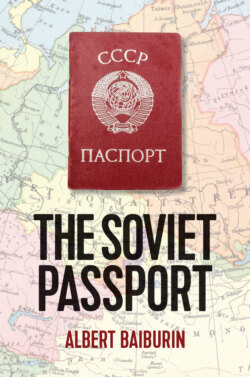Читать книгу The Soviet Passport - Albert Baiburin - Страница 22
7.
ОглавлениеIn recent times interest has grown noticeably in the study of documents, such as the passport and others, which confirm identity. Evidence of this is the international project, Documenting Individual Identity: Historical and Comparative Perspectives since 1500 (IdentiNet) led by Jane Caplan and Edward Higgs, in which identity documents are the principal items of study. Under the auspices of this project a series of research papers has been published dedicated to the history and functioning of identity documents in a number of cultural traditions.45 Amongst these, of particular interest is the picture John Torpey presents of the evolution of the passport, which looks closely at the efforts of the authorities to establish control over movement since the time of the French Revolution. Certainly, there were ups and downs in this process. There was a weakening of control in the second half of the nineteenth century, brought about by the construction of the railways and a sharp rise in mobility; but this was followed by a period when tighter control was imposed once again.46
These processes did not pass Russia by; but, naturally, there they had their own specific nature. The history of the Russian passport has been examined mainly in the context of the development of tax legislation.47 It is only comparatively recently that works have appeared devoted specifically to the study of the passport and the passport system. One of these is the research into the history of the Russian passport carried out by Mervyn Matthews.48 The main emphasis in Matthews’ work is on the authorities’ efforts to control movement, beginning with the appearance of the passport in Russia and up to the introduction of the Soviet passport. As Matthews showed, the development of the passport system went hand-in-hand with the process of the stratification of Russian society, and somehow the issuing of passports strengthened and reflected this process. Before the introduction of passports in the Soviet period, the registration of the population and the supervision of this system was done by measures such as compulsory military registration, labour conscription and the decree on registering your place of abode, which, in Matthews’ opinion, inevitably led to the introduction of the passport system.
It is also worth noting the authoritative study by Valentina Chernukha of the development of the Russian passport over the course of two centuries, from 1719 to 1917.49 This was based on archival and previously published sources, and was published in 2007. As well as examining the historical evolution of the passport system, particular attention is paid in Chernukha’s book to the role of the passport as a means of police control, which makes it an invaluable manual for future examination of this subject.
It is only recently that the Soviet passport has become an object of study, with the opening of the archives in the 1990s. There are, of course, earlier works by Soviet historians, but their ideological content tended to give them a very particular focus.50 Much post-Soviet research takes a completely opposite view (for example, the title of an article by Valery Popov speaks volumes: ‘The passport system of Soviet serfdom’).51 In those Soviet-era works, the Soviet passport (and more widely, the passport system) is seen in the broad context of the liberation of the individual and the creation of the new Soviet person; in the post-Soviet ones, it is seen as playing a role in the suppression of the individual and the use of the passport as a repressive measure.
We should point out that the repressive functions of the Soviet passport system and the way it was used to control the movement of the population within the country have been widely researched.52 Many of these studies (especially Russian research of the post-Soviet period) interpret the system inherently as one in which there is an anonymous, active state at work on one side, and on the other, an equally anonymous but passive society which is obliged to carry out all the orders of this state. Of course, the way in which the Soviet passport system functioned was much more complicated than this, and it cannot simply be squeezed into such a template without mentioning that the details that were gathered by the registration of passports were used not just for coercive purposes.53
The circumstances surrounding the introduction of the passport system in the 1930s still need examining. What role did the passport system play in ‘establishing order’? What did its geographical spread look like? And one specific question: was it deliberately aimed at restricting the mobility of the rural population of the USSR? These and other issues are discussed in the works of Nathalie Moine and David Shearer, which have proved invaluable for me in studying these subjects.54 I shall expound my views on these questions in chapter 3.
Sheila Fitzpatrick’s works were of particular importance in examining the various categories of passports for purposes of identification, in particular her article on ascribing people to a particular class. In this, she examined the efforts of the Soviet authorities to construct society by ‘branding’ people according to distinguishing social signs, with the intention of exposing ‘socially undesirable elements’.55 The invention of ‘classes’ by the Soviet authorities turned out to be so productive that it largely determined how identity was viewed in the passport, both in social terms and for the different ethnicities across the country.56 Indeed, particular attention has been paid to researching the introduction and strengthening of national affiliations.57
Even from such a short description of research that has already been carried out, it will be clear that the history of the Soviet passport system has been well studied. But this is not the case with the passport itself; neither its contents, nor, moreover, how those for whom it was intended took part in its creation and use.
